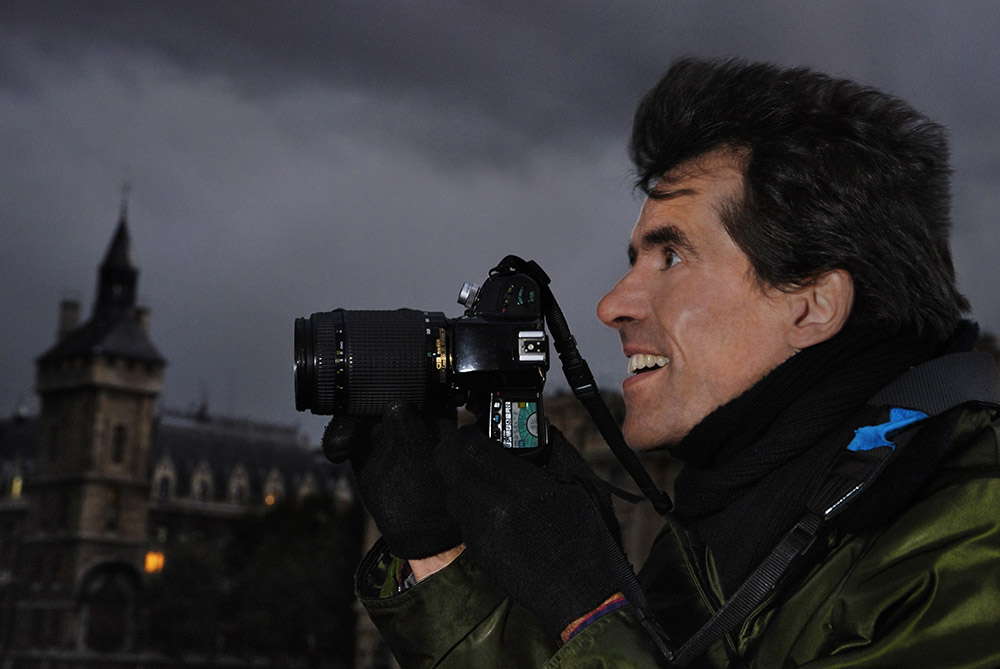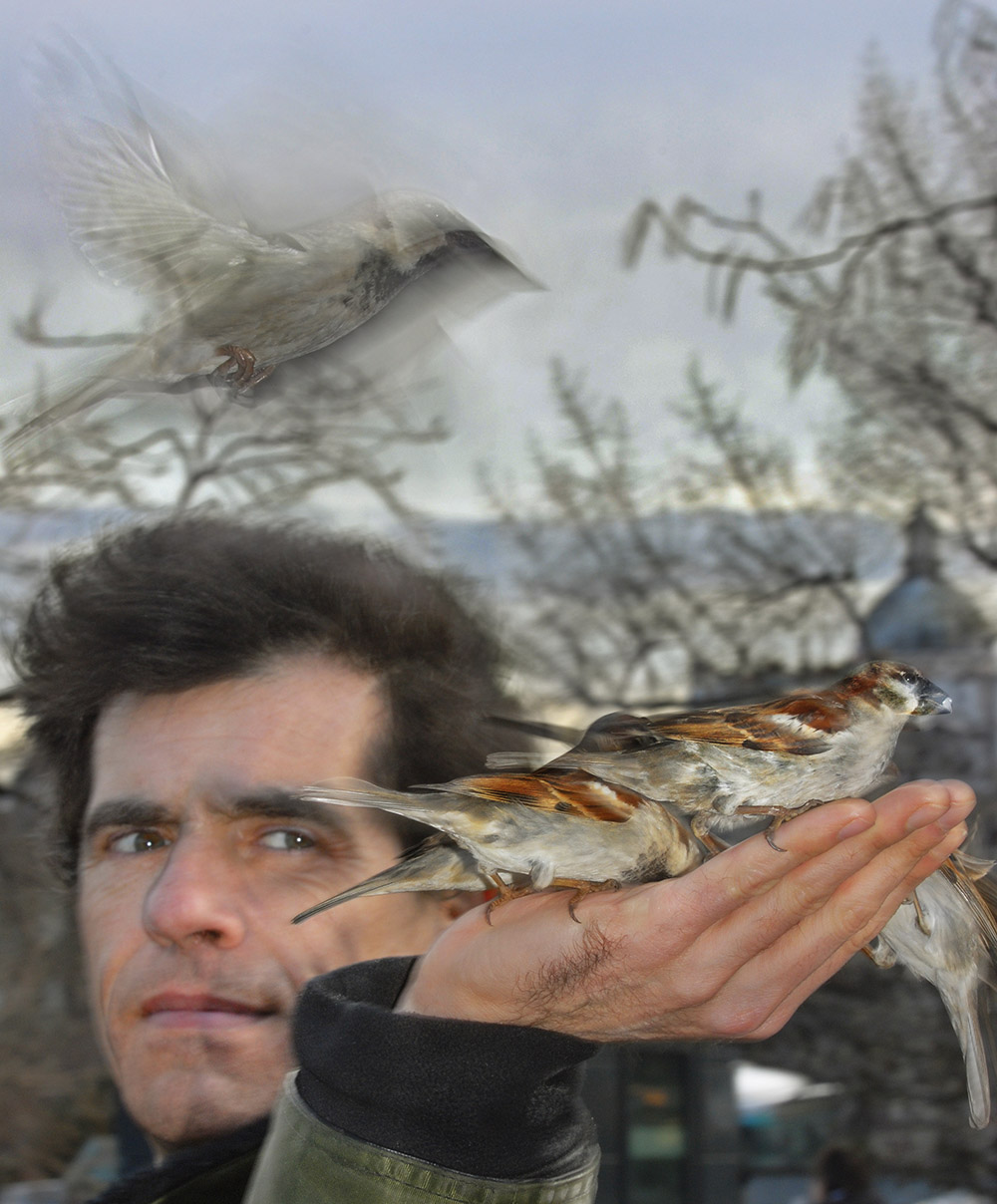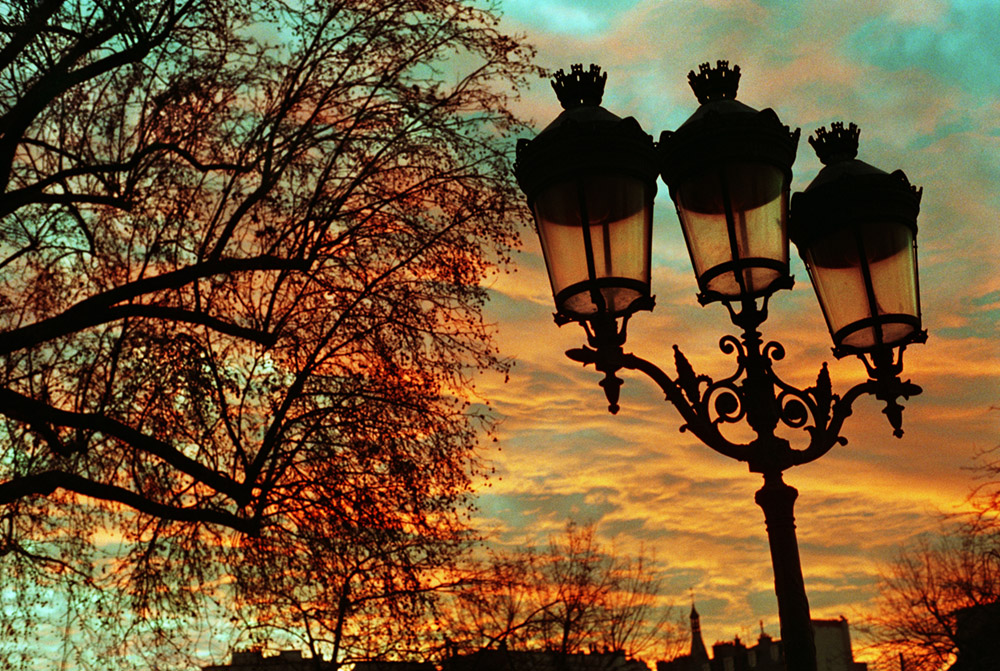Is there a place, time or season that you most enjoy when photographing Paris?

David Henry photographing the Conciergerie from place du Châtelet. This is a picture taken by one of my photo students while I was teaching her the importance of the flash in portrait photography.
Basically, anywhere in the middle of Paris, from place de la Bastille to place de la Concorde, along the River Seine and about a half-mile inland on both sides are fine, plus Montmartre and some other scattered areas are good choices, like Belleville, la Butte aux Cailles, the Catacombes, les Passages Couverts, parc des Buttes Chaumont and cimetière Père Lachaise. My choice of destinations is tends towards neighborhoods that are alive, with families, kids, Parisians of all ages, out and about, with shops, cafés, boutiques, restaurants open late, etc.
Any time during the day is fine for taking pictures of Paris. Many people say the middle of the day between noon and 4:00 pm is the worst because the light is so vertical and harsh. I empathize with this line of reasoning, on the other hand the clouds often roll over the skies of Paris after 1:00 pm, so it serves no purpose waiting until 5:00 pm if the skies have already been clouded over for hours. Because of this I’m happy to see the sun in Paris no matter what time of day it is.

One of my favorite afternoon activities: feeding sparrows in front of Notre-Dame Cathedral. There are at least two other places where you can hand-feed sparrows in Paris: next to l’arc du Carrousel in the jardin des Tuileries and in the jardin du palais Royal. —photo by Justin Massiot
When the weather in Paris is indeed proving itself to “be problematic”, the solution is to wait until nighttime, when it doesn’t matter if the sky is clouded over and Paris turns in to the City of Light.
Any season is fine with me also. Being a New Englander, I appreciate the colors of fall foliage, on the other hand it can be much easier taking pictures of buildings and monuments in the winter when there aren’t any leaves on the trees. The summer is naturally the best season for taking classic urban landscape pictures with full-open blue skies and puffy white clouds. And the sun goes down at 10:00 pm, meaning the light is golden, softer and comes in at a magic low angle between 7:00 and 9:00 pm. In the winter I keep an eagle eye on the weather forecasts hoping for snow as pictures of snow in Paris are rare and valuable since it hasn’t particularly snowed much here since the mid-1980s.
How can someone take a good, powerful and memorable photograph with a point-and-shoot camera?
When it’s sunny out the important thing is to “compose according to the light”; take your pictures either entirely in the sun or entirely in the shadows and avoid compositions that are too evenly divided between the sun and the shadows because that will always be frustrating. In such a photo the bright areas will be overexposed, fried out and empty, or the shadows will be entirely dead and black and there’s no setting that allows the correct exposure everywhere in such a photo. Between the two I always go straight for the sun-lit areas, because it’s the sun that brings out textures, patterns, motifs, etc, on buildings, façades, trees and so forth.
Concretely, “composing according to the light” means zooming in more, to get rid of the shadows. Pictures taken at a wide-angle focal length often have wild differences in brightness. Along these same lines, avoid backlit situations and keep your back to the sun. All of this is less noticeable on a cloudy day though still it’s best to keep the sun behind you even when the sun is hidden behind clouds. As it happens all of this advice holds true even with the most expensive of cameras.

A sunset on île de la Cité, taken in front of Notre-Dame. As beautiful as the colors may be, a sunset can at best be only a backdrop. Before taking this picture I roamed around for five minutes, searching for something to put in front of the sunset to serve as a subject for the photo.
Another strong point about point-and-shoot cameras to keep in mind is that they are very good for macro photography because they give generous amounts of depth of field. Depth of field is always shallow in macro photography while “big sensor” cameras take pictures with (much) less depth of field as compared to compact cameras and telephones. Thus macro photos taken with a point-and-shoot cameras will generally look sharper as compared to “professional” cameras.
How can a visiting photographer really capture the essence of the city in their photographs?
Beauty is in the eye of the beholder and “the essence of the city” will mean something different to each and every person. That said, I’d say the key is to have at least a few days at your disposal and to be adventurous, optimistic & energetic and put in the time. Keep walking and if you feel underwhelmed by some place you’re in, keep walking, head on to the next neighborhood you have in mind. Look at maps: when you see streets that are windy, meandering, this means it’s an older part of town. Don’t follow some straight, long, wide streets, head away from them in to the historic quarters.

The great advantage of Aperture Priority exposure mode is that it works 24 hours a day. At night shutter speeds can be slow or very slow, during the day shutter speeds will be fast or extremely fast though from noontime to midnight pictures will be properly exposed, unlike Shutter Speed priority. The “scene modes” won’t help because there might be just one of them that allows slow shutter speeds and just one other that seeks to obtain fast shutter speeds.
Is there a camera setting that you use as your “go to” setting for your favorite photos?
I take 95% of my pictures in Aperture Priority Automatic, indicated by an A on most cameras (AV on Canon and Pentax cameras). I keep the lens stopped down halfway (ƒ8–ƒ11 on most reflex lenses), I keep tabs on the shutter speed and raise or lower the sensitivity (and/or open or close the lens) in order to obtain faster or slower shutter speeds. Since the late 1990s cameras have all kinds of silly scene modes, with inane icons of hats, flowers, mountains, snowmen, skiers, palm trees, fireworks, etc, all of them are quite useless and Green Mode (the completely automatic mode) is frankly the worst…
What final piece of advice would you give an amateur photographer visiting Paris?
Get “the lay of the land” when you arrive and take a look at what pictures have already been taken. Look through postcards on racks outside shops at least, browse the books of photographs inside shops. You’ll see pictures you like, others you will be less enchanted with. Obviously this isn’t a question of slavishly reproducing an image you have seen, naturally you will reinterpret the concept in your own way. In any case by looking through the classic tourist pictures you’ll have an idea of which neighborhoods you’d like to visit and what kinds of photos you will want to take there.
I learned this trick when I saw the Guggenheim Museum in New York at the age of 15. I was fascinated with the interior architecture, though frustrated because I didn’t have much of an idea of how to take compelling pictures there. I sauntered in to the gift shop, looked at the postcards and books for ten minutes, came back and took at least a dozen fine photographs. Thus this tip will work for any place in the world you’ll go to.

Melisa Piot taking pictures in the Forum des Halles before that incarnation of the shopping center was torn down in 2010.
What kind of camera/equipment do you shoot with?
I’ve used Nikon cameras since the moment I was able to afford one: an FM at $200 at the age of 19. I bought my first digital reflex, a Nikon D90, at the end of 2008 and was quite happy with it until I bought a D600 at the end of 2012, which is all the better. To this day I still have a big preference for Nikons because of their ease of use, ergonomy and interface. Sony has made great progress since 2010 in designing light and small cameras with big sensors, though for ease of use I still prefer Nikon.
I make a point of buying additional accessories each year, things that I suspect will help significantly, will make picture-taking easier or that much more fun. It took a while for digital photography to come out of its adolescent phase, though really, any (even the cheapest) digital reflex made since 2011 is capable of taking perfectly fine pictures of professional quality.
—interview by Sophie Delon, managing editor at parisiensalon.com, June 23rd 2011